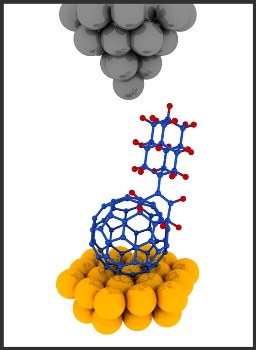Scientists from the USA and Europe have collaborated to develop a molecular rectifier that can reduce the size of chip components to the size of molecules. Two unusual forms of carbon were joined to create the rectifier. One of the forms was like a diamond, while the other was like a soccer ball.
 Illustration of a buckydiamondoid molecule under a scanning tunneling microscope (STM). In this study the STM made images of the buckydiamondoids and probed their electronic properties. Credit: SLAC National Accelerator Laboratory
Illustration of a buckydiamondoid molecule under a scanning tunneling microscope (STM). In this study the STM made images of the buckydiamondoids and probed their electronic properties. Credit: SLAC National Accelerator Laboratory
Scientists from Stanford University, Germany’s Justus-Liebig University, Ukraine’s Kiev Polytechnic Institute and Belgium’s Catholic University of Louvain collaborated in this project.
Electronic circuits, consist primarily of three components – an electron conducting material, rectifiers for controlling the electron flow in a specific direction and transistors that allow or disallow the electron flow.
Tiny carbon cages that are bonded in the same way as diamond are called Diamondoids, while hollow carbon spheres are called buckyballs. Diamondoids have an extremely low weight; less than a billionth of a billionth of a carat.
In earlier studies, researchers had found that a single diamondoid layer on a metal surface had the ability to emit an electron beam. For this study, Jeremy Dahl and Robert Carlson of SLAC’s Stanford Institute for Materials and Energy Sciences (SIMES) produced Diamondoids which were sent to Justus-Liebig University where chemists attached them to buckyballs. This led to the formation of buckydiamondoids.
SIMES researchers tested these buckydiamondoids using a scanning tunneling microscope and studied the electronic behavior of the material. The hybrid material demonstrated exceptional rectifier properties. In the direction of electron-spitting diamondoid to the electron-catching buckyballs, the flow of current was found to be 50 times faster.
Stanford associate professor of physics, Hari Manoharan, stated that this was the first molecular rectifier to be made from hydrogen and carbon. To advance this study, the possibility of building transistors using the same simple ingredients must be considered. Further, the present findings could help increase the possibility of creating molecular electronics.
The U.S. Department of Energy Office of Science has provided funding for this study which has been published in Nature Communications.